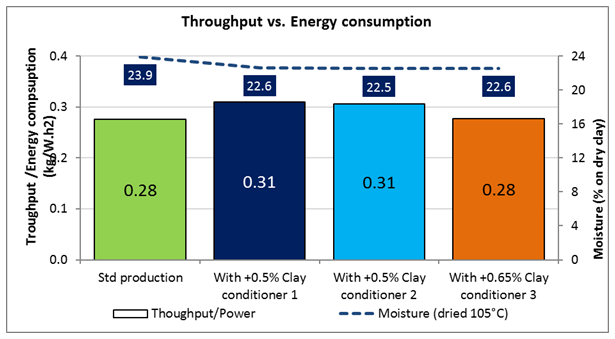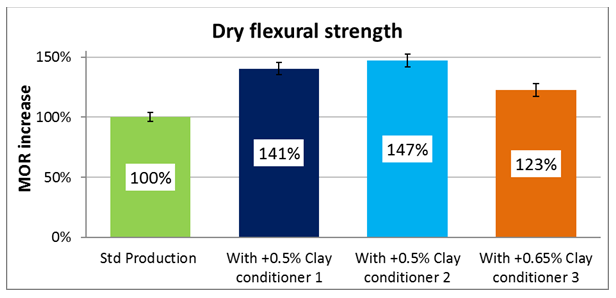
In today’s economic climate and with manufacturers desire to ensure strong sales whilst optimizing profits what options are open to help reduce costs in production?
One could probably summarize that the “easiest” options available to reduce costs could be raw materials, production, drying and firing and reducing losses - in fact it could be argued that all of these options go hand in hand.
Change in raw materials
Most brick works will have a clay quarry either on-site or in close proximity but on occasion will have to import clays from further afield, these clays may be either integral to body type or they could be high quality plastic clays required to aid production.
Reduction in production costs
Whether you are extruding or pressing products one of the biggest areas of cost is the energy required to produce the product be it extrusion amperage, water additions or total energy costs. Furthermore the ability to produce products faster will help to hit targets quicker and thus reduce machine time and associated energy costs.
Improved drying and firing
Production, drying and then firing are normally seen as very strongly interlinked. You can only produce as many products as you can dry and subsequently can only dry as much as you can fire. If you are able to dry faster without incurring losses and produce a product with a high green strength ensuring it can be fired quicker then naturally you would be able to hit production targets faster and with less energy usage.
Reduced losses
This is probably the quickest way to reduce costs but not necessarily the easiest. The main causes of losses are seen as handling, cracking, scumming, breakages and chipping which with increased strength and the use of anti-scumming agents can quite quickly be reduced/overcome. The added benefits of increased strengths tie in nicely with the above mentioned points in that production can be increased, drying times can be reduced and firing times can improved too.
On speaking to manufacturers about these issues the consensus is that a clay conditioner is the most versatile and widely used additive in addressing the points above and reducing costs. Below you can find examples of the positive benefits of adding a clay conditioner within your production process. Besides these benefits given below for the manufacturing side of cost reduction clay conditioners have also been shown to be very versatile in replacing high value plastic clays. They have a natural tendency to improve plasticity/workability of clay mixes enabling either cheaper plastic clays or a reduced addition rate of high value plastic clays.
|
|
Parameters |
||||||
|
Clay type and process |
Production rate |
Extruder amperage |
Power consumption |
Relative green strength |
Moisture content |
Dry strength |
Extruder efficiency |
|
Carboniferous shale – extruded |
+5.8% |
-15.6% |
-20.5% |
+9.0% |
-0.1% |
+11.8% |
+26.0% |
|
Carboniferous shale – extruded |
NIL |
-14.8% |
-14.3% |
+16.0% |
NIL |
+13.5% |
+16.7% |
|
Carboniferous shale – extruded/pressed |
NIL |
NIL |
NIL |
+28.3% |
-1.2% |
N/A |
+1.4% |
|
Carboniferous Ref U/Clay – extruded |
+9.9% |
-10.2% |
-17.8% |
+14.6% |
-0.6% |
N/A |
+22.6% |
|
Carboniferous Buff Fireclay – extruded |
+20.5% |
-5.0% |
-21.2% |
+21.2% |
-0.7% |
N/A |
+27.9% |
|
Devonian Shale –extruded |
+5.7% |
-13.7% |
-18.8% |
+13.0% |
-0.3% |
+33.3% |
+23.5% |
|
Keuper Marl –extruded |
+1.1% |
-7.8% |
-8.7% |
+24.6% |
-0.9% |
+20.3% |
+10.7% |
|
Brickearth – extruded and repressed |
+1.1% |
-21.2% |
-22.4% |
+26.2% |
-0.6% |
+23.8% |
+29.7% |
|
Etruria Marl – extruded |
+7.0% |
-15.5% |
-20.8% |
+23.9% |
-0.1% |
+16.4% |
+26.4% |
|
Non-clay refractory – extruded |
+13.7% |
-6.9% |
-17.4% |
+30.0% |
-0.5% |
N/A |
+21.5% |
|
Hastings beds – soft mud moulded |
NIL |
N/A |
N/A |
N/A |
-1.5% |
+113.3% |
N/A |
|
Weald clay – soft mud moulded |
NIL |
N/A |
N/A |
N/A |
-0.7% |
+35.3% |
N/A |
Columns 1-4, 6 and 7 show % changes in stated parameters as a direct result of incorporating 0.5% by weight of clay conditioner into otherwise standard production. Column 5 shows the actual reduction in moisture content.


Read our ebook if you want to know more about clay conditioners. Download here!





